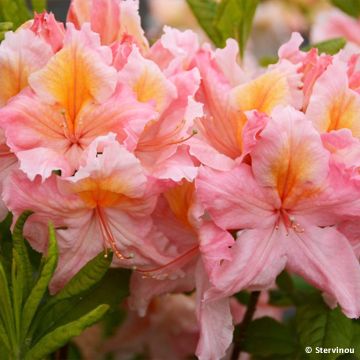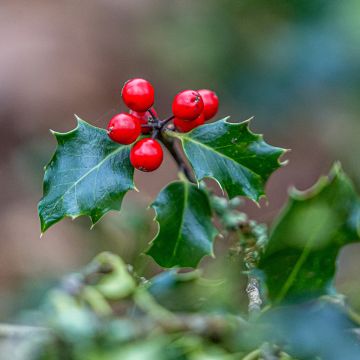

Rhododendron Mrs T.H. Lowinsky
Rhododendron Mrs T.H. Lowinsky
Rhododendron Mrs T.h.lowinsky
Rhododendron
A pendulous young plant, jostled during the journey, is seen with dry leaves: frost can be a possibility.
monique, 11/02/2023
Special offer!
Receive a €20 voucher for any order over €90 (excluding delivery costs, credit notes, and plastic-free options)!
1- Add your favorite plants to your cart.
2- Once you have reached €90, confirm your order (you can even choose the delivery date!).
3- As soon as your order is shipped, you will receive an email containing your voucher code, valid for 3 months (90 days).
Your voucher is unique and can only be used once, for any order with a minimum value of €20, excluding delivery costs.
Can be combined with other current offers, non-divisible and non-refundable.
Home or relay delivery (depending on size and destination)
Schedule delivery date,
and select date in basket
This plant carries a 24 months recovery warranty
More information
We guarantee the quality of our plants for a full growing cycle, and will replace at our expense any plant that fails to recover under normal climatic and planting conditions.
Would this plant suit my garden?
Set up your Plantfit profile →
Description
The Rhododendron Mrs T.H. Lowinsky is a very beautiful hybrid variety, hardy, vigorous, and more tolerant of the sun than many other varieties. Its late spring flowering, displays bouquets of large white-pink flowers speckled with brown-orange at the throat. Like all rhododendrons, it is only happy in non-chalky soils, acidic, moist, and rich in humus. A beautiful specimen for ericaceous beds, also to be displayed in a large pot on a semi-shaded terrace.
Rhododendrons belong to the very diverse family of Ericaceae, which includes, among others, heathers, and strawberry trees... The diversity of rhododendrons is extraordinary - and complex - and hybrids are extremely numerous. The Mrs T.H Lowinsky variety was created in 1958. The bush, with a rather rounded habit, reaches approximately 2m (6.6ft) in all directions at maturity. Its scentless flowering occurs in May-June taking the form of funnel-shaped flowers with a diameter of 7.5cm (3in), arranged in bouquets of up to 14 units. The petals are white, washed with very pale pink to mauve, the upper petal displaying a beautiful speckling of brown on an orange background. The foliage persists in winter. It is composed of leathery and thick leaves, broadly elliptical to slightly obovate, measuring up to 11.4cm (4.5in) long, glossy, and dark green.
This Rhododendron Mrs T.H Lowinsky will make a magnificent subject in the background of a bed, in association with camellias, Japanese azaleas, or other rhododendrons: remember to choose varieties that do not flower at the same time in order to extend the period of interest. At the base of the rhododendrons, opt for Hostas, Hakonechloa, or the rarer Kirengeshoma palmata in a lovely Japanese scene. It is also possible to grow it in a large pot (always in ericaceous soil) when it is important to ensure watering with non-chalky water, without flooding the soil.
Report an error about the product description
Rhododendron Mrs T.H. Lowinsky in pictures




Plant habit
Flowering
Foliage
Botanical data
Rhododendron
Mrs T.h.lowinsky
Ericaceae
Rhododendron
Cultivar or hybrid
Other Rhododendron and Azalea A to Z
View all →Planting and care
Plant the Rhododendron Mrs T.H Lowinsky in a shaded, partially shaded or even mildly sunny position, protected from cold and drying winds, in a moist, humus-rich, light, acid or neutral soil. Like all ericaceous plants, it does not tolerate chalky soils or heavy soils saturated with water in winter. If the soil remains moist in summer, this rhododendron will also tolerate morning sun exposure. Avoid planting at its base, as its shallow roots do not tolerate competition from other plants, especially for water.
Dig a hole three times larger than the pot. Soak the root ball in lime-free water and plant the bush at the collar level, in a mixture composed of 1/4 organic matter, leaf mold, gravel or pumice and loam. Water generously and keep the soil moist in summer. Azaleas and Rhododendrons have a shallow root system. As a result, they dislike long periods of drought. This is why soil enriched with humus, and abundant watering during dry periods is recommended. In addition, this root system is not very strong, which is why it is essential to lighten heavy soils with free-draining materials (gravel, pumice, clay balls) at planting. Apply a layer of shredded pine bark mulch around the base of the bush every spring to maintain soil moisture while preserving an acidic pH.
Maintenance consists of cutting off faded flowers in summer and removing dead branches. Azaleas and Rhododendrons can sometimes be attacked by weevils, which eat the edges of leaves and rootlets, as well as the famous "rhododendron beetle," which does not often cause significant damage. Effective biological solutions are now available against weevils. Yellowing of the leaves (chlorosis) in Rhododendron indicates poor uptake of iron from the soil and can cause premature death of the plant. While chalk is often the cause, poorly drained soil or deeply planted root balls can also cause the phenomenon.
"Rhodos" thrive when planted in chalk-free soil and in a humid environment. Their cultivation in warmer and drier climates is often doomed to failure in the long run, despite all attempts to acclimatize them.
Planting period
Intended location
Care
-
, onOrder confirmed
Reply from on Promesse de fleurs
Similar products
Haven't found what you were looking for?
Hardiness is the lowest winter temperature a plant can endure without suffering serious damage or even dying. However, hardiness is affected by location (a sheltered area, such as a patio), protection (winter cover) and soil type (hardiness is improved by well-drained soil).

Photo Sharing Terms & Conditions
In order to encourage gardeners to interact and share their experiences, Promesse de fleurs offers various media enabling content to be uploaded onto its Site - in particular via the ‘Photo sharing’ module.
The User agrees to refrain from:
- Posting any content that is illegal, prejudicial, insulting, racist, inciteful to hatred, revisionist, contrary to public decency, that infringes on privacy or on the privacy rights of third parties, in particular the publicity rights of persons and goods, intellectual property rights, or the right to privacy.
- Submitting content on behalf of a third party;
- Impersonate the identity of a third party and/or publish any personal information about a third party;
In general, the User undertakes to refrain from any unethical behaviour.
All Content (in particular text, comments, files, images, photos, videos, creative works, etc.), which may be subject to property or intellectual property rights, image or other private rights, shall remain the property of the User, subject to the limited rights granted by the terms of the licence granted by Promesse de fleurs as stated below. Users are at liberty to publish or not to publish such Content on the Site, notably via the ‘Photo Sharing’ facility, and accept that this Content shall be made public and freely accessible, notably on the Internet.
Users further acknowledge, undertake to have ,and guarantee that they hold all necessary rights and permissions to publish such material on the Site, in particular with regard to the legislation in force pertaining to any privacy, property, intellectual property, image, or contractual rights, or rights of any other nature. By publishing such Content on the Site, Users acknowledge accepting full liability as publishers of the Content within the meaning of the law, and grant Promesse de fleurs, free of charge, an inclusive, worldwide licence for the said Content for the entire duration of its publication, including all reproduction, representation, up/downloading, displaying, performing, transmission, and storage rights.
Users also grant permission for their name to be linked to the Content and accept that this link may not always be made available.
By engaging in posting material, Users consent to their Content becoming automatically accessible on the Internet, in particular on other sites and/or blogs and/or web pages of the Promesse de fleurs site, including in particular social pages and the Promesse de fleurs catalogue.
Users may secure the removal of entrusted content free of charge by issuing a simple request via our contact form.
The flowering period indicated on our website applies to countries and regions located in USDA zone 8 (France, the United Kingdom, Ireland, the Netherlands, etc.)
It will vary according to where you live:
- In zones 9 to 10 (Italy, Spain, Greece, etc.), flowering will occur about 2 to 4 weeks earlier.
- In zones 6 to 7 (Germany, Poland, Slovenia, and lower mountainous regions), flowering will be delayed by 2 to 3 weeks.
- In zone 5 (Central Europe, Scandinavia), blooming will be delayed by 3 to 5 weeks.
In temperate climates, pruning of spring-flowering shrubs (forsythia, spireas, etc.) should be done just after flowering.
Pruning of summer-flowering shrubs (Indian Lilac, Perovskia, etc.) can be done in winter or spring.
In cold regions as well as with frost-sensitive plants, avoid pruning too early when severe frosts may still occur.
The planting period indicated on our website applies to countries and regions located in USDA zone 8 (France, United Kingdom, Ireland, Netherlands).
It will vary according to where you live:
- In Mediterranean zones (Marseille, Madrid, Milan, etc.), autumn and winter are the best planting periods.
- In continental zones (Strasbourg, Munich, Vienna, etc.), delay planting by 2 to 3 weeks in spring and bring it forward by 2 to 4 weeks in autumn.
- In mountainous regions (the Alps, Pyrenees, Carpathians, etc.), it is best to plant in late spring (May-June) or late summer (August-September).
The harvesting period indicated on our website applies to countries and regions in USDA zone 8 (France, England, Ireland, the Netherlands).
In colder areas (Scandinavia, Poland, Austria...) fruit and vegetable harvests are likely to be delayed by 3-4 weeks.
In warmer areas (Italy, Spain, Greece, etc.), harvesting will probably take place earlier, depending on weather conditions.
The sowing periods indicated on our website apply to countries and regions within USDA Zone 8 (France, UK, Ireland, Netherlands).
In colder areas (Scandinavia, Poland, Austria...), delay any outdoor sowing by 3-4 weeks, or sow under glass.
In warmer climes (Italy, Spain, Greece, etc.), bring outdoor sowing forward by a few weeks.


















































